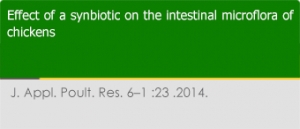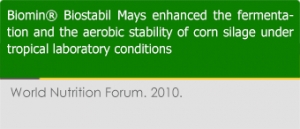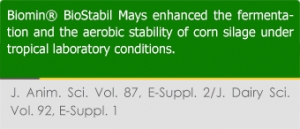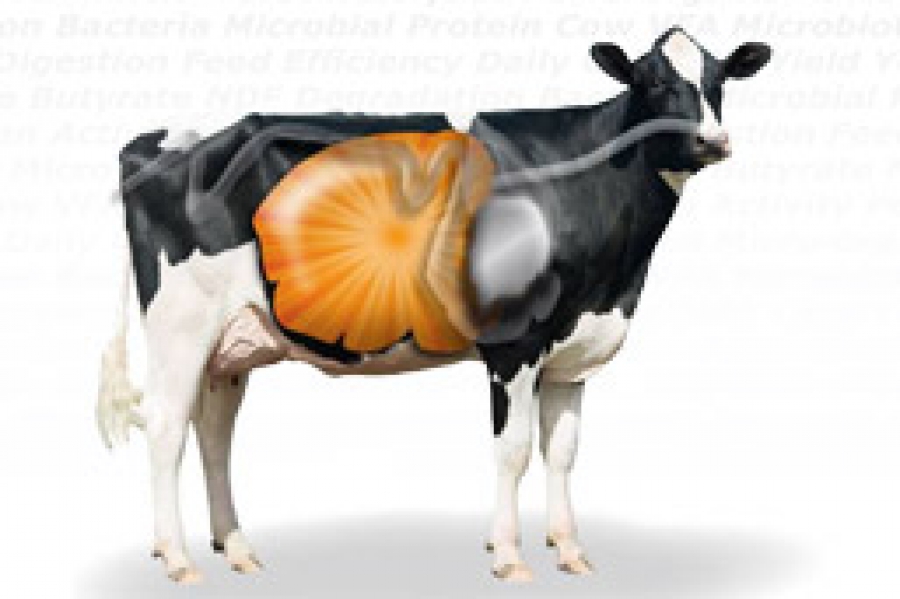Sinsia Bjedov, Mirjana Dukic Stojcic, Lidija Peric, Dragan Zikic, Marina Vukic Vranjes
Use of probiotics can be alternative to antibiotics which are added to food as growth stimulators. Investigation of the effect of probiotics and antibiotics was done on experimental farm ‘’Pustara’’, of the Faculty of Agriculture in Novi Sad. Trial consisted of three groups of chickens in five repetitions. First group was control, second group received probiotic in the water and food, and third group received antibiotic in food. Final body weight was (I) 2179 g, (II) 2190 g and in group (III) 2158 g. In first group, feed conversion was 1,93, mortality 4,27% and production index had value of 257, in second group 1,90, 3,47% mortality and PI 260. In third group, conversion was 1,93, mortality 2,40%, and PI value 265. Obtained results indicate positive effect of probiotic on production results, whereas, contrary to expectations the
W. A. Awad, K. Ghareeb, S. Abdel-Raheem, and J. Böhm
A feeding trial was conducted to investigate the effects of dietary supplementations of synbiotic and probiotic on broiler performance, carcass yield, organs weights, and histomorphological measurements of small intestine. Six hundred 1-d-old broiler chicks were randomly assigned to 1 of 3 dietary treatments for 5 wk. The dietary treatments were 1) control, 2) basal diets supplemented with synbiotic (1 kg of Biomin IMBO/ ton of the starter diets and 0.5 kg/ton of the grower diets), 3) basal diets supplemented with probiotic (1 kg of a homofermentative and a heterofermentative Lactobacillus sp./ton of feed). The BW, average daily weight gain, carcass yield percentage, and feed conversion rate were significantly (P < 0.05) increased by the dietary inclusion of the synbiotic compared with the control and probiotic-fed broilers.
Seyed Morteza Dibaji, Alireza Seidavi, Leila Asadpour, and Fernando Moreira da Silva
The current experiment was conducted to evaluate the effect of a synbiotic (Biomin Imbo) on intestinal microflora of Ross broiler chickens. A total of 200 male chickens were randomly divided into 20 groups of 10 birds each, kept in 20 pens (1.5 × 1 m each), and fed for 42 d at different synbiotic levels. Treatments included (1) a basal diet without synbiotics (control), (2) a basal diet with synbiotic levels proposed by the manufacturer, (3) a basal diet with synbiotic levels 25% lower than those proposed by the manufacturer, (4) a basal diet with synbiotic levels 50% higher than those proposed by the manufacturer, and (5) a basal diet with synbiotic levels 25% higher than those proposed by the manufacturer. At the end of the 42-d feeding period, 1 bird was randomly selected from each experimental unit, humanely euthanized,
M. Hossein Yazdi, H. Amanlou, H.R.Mirzaei-Alamouti, M.T. Harkinezhad, A. Nabipour, E. Mahjoubi, N.Aghaziarati, G.R. Noori, L.H. Baumgard
Glucose appears to be a preferred systemic fuel during heat stress (HS) in a variety of species. Increasing the dietary grain contact can enhance the post-absorptive carbohydrate status, but providing excessive fermentable starch can cause rumen disorders and this is especially true during HS. Current study objectives were to evaluate the effects of a glycerol based supplemental product on growth and metabolic variables in Holstein bull calves during controlled HS. Before the star of the experiment, bull calves (n=14; 163.6 ± 30.1 kg body weight) were subjected to thermal neutral conditions [26.5± 3.4°C and a temperature – humidity index (THI) of 70.4 ± 2.8] for 7 d (period 1; P1). During this period, productive parameters as well as blood metabolites were measured and used as covariates for the subsequent HS period.
E. Mahjoubi, H. Amanlou, M. Hossein Yazdi, N. Aghaziarati, G. R. Noori, C. I. Vahl, B. J. Bradford, and L. H. Baumgard
Thirty-two Afshari lambs were used in a completely randomized design with a 2 × 2 factorial arrangement of treatments to evaluate a nutritional supplement designed to provide multiple gluconeogenic precursors during heat stress (HS). Lambs were housed in thermal neutral (TN) conditions and fed ad libitum for 8 d to obtain covariate data (period 1 [P1]) for the subsequent experimental period (period 2 [P2]). During P2, which lasted 9 d, half of the lambs were subjected to HS and the other 16 lambs were maintained in TN conditions but pair fed (PFTN) to the HS lambs. Half of the lambs in each thermal regime were fed (top-dressed) 100 g/d of a feed supplement designed to provide gluconeogenic precursors (8 lambs in HS [heat stress with Glukosa {HSG}] and 8 lambs in PFTN [pair-fed thermal neutral with Glukosa])
K. Schondorfer, Y. Y. Acosta Aragon, A . Klimitsch, and G. Schatzmayr
It is commonly know that corn silage ferments well due to the presence of fermentable sugars. However , in contrast to green forages, it is usually prone to aerobic deterioration due to a long growth period on the field and accordingly a high natural contamination with moulds and yeasts. Therefore it is crucial to improve the content of stabilizing acids (e.g. acetic acid, propionic acid) in a way that secures effective suppression of aerobic spoilage organisms upon opening the silo.
This goal can be reached by directly adding stabilizing acids, which are usually expensive and/ or corrosive , or by producing them during the fermentation process, by addition of heterofermentative lactic acid bacteria .
A. A. Rodriguez,Y. Acosta Aragon, and E. Valencia
An experiment was conducted to determine the effects of the silage additive Biomin® BioStabil Mays ( BSM, blend of homo- and heterofermentative lactic acid bacteria) on the fermentation characteristics and aerobic stability of corn whole plant (QPM variety) growth and ensiled in Puerto Rico. Corn was harvested 75 d after planting and chopped finely. Prior to ensiling, the vegetative material of the trial group was treated with BSM (1 x 105 cfu/g silage). A control group went untreated. Treatments were applied to weighted portions of corn forage , manually mixed, and packed into PVC laboratory silos. Samples of fresh forage of each treatment were taken at 0,3,45 and 90 d of fermentation ( triplicate silos of each treatment were available), analyzed for PH, chemical composition,
A. A. Rodríguez*1, Y. Acosta-Aragón2, and E. Valencia1, 1University of Puerto Rico, Mayaguez, PR, 2Biomin GmbH, Austria.
An experiment was conducted to determine the effects of the silage additive Biomin® BioStabil Mays (BSM, blend of homo- and heterofermentative bacteria) on the fermentation characteristics and aerobic stability of corn whole plant (QPM variety) growth and ensiled in Puerto Rico. Corn was harvested 75 d after planting and chopped finely. Prior to ensiling, the vegetative material was treated or not with BSM (1 x 105 cfu/ g silage). Treatments were applied to weighted portions of corn forage, manually mixed, and packed into PVC laboratory silos. Samples of fresh forage and triplicates silos of each treatment were taken at 0, 3, 45 and 90 d of fermentation, analyzed for pH, chemical composition, and fermentation products.
Simon Menanteau-Ledouble, Ines Krauss, Rui Alexandre Goncalves, Barbara Weber, Gonçalo Abreu Santos, Mansour El-Matbouli
Demand for more environmentally friendly practices have led to the adoption of several feed supplements by the fish farming industry. In the present study, we investigated a commercially available formula that includes a mixture of three compounds: organic acids, a phytochemical and Biomin® Permeabilizing Complex. This mixture demonstrated antimicrobial properties in vitro and was able to inhibit growth of multiple species of aquatic bacterial pathogens, including Aeromonassalmonicida.
Bacterial challenge was performed using A. salmonicida and three exposure routes: intra-peritoneal injection, immersion, and cohabitation.
A. Kovàcs, R. Urbaityte, N. Roth, and S. Weidong
Permeabilizing substances can improve the efficacy of organic acids and phytochemicals.An experiment was conducted to study the effects of dietary supplementation with a conventional acidifier versus a blend of organic acids combined with cinnamaldehyde and a permeabilizing substance (Biotronic Top3, Biomin, Austria) on growth performance, livability and cecum microbiota. Six hundred day-old AAbroiler chicks were randomly assigned to 3 treatments with 4 replicates in each treatment and 50 broilers per replicate. A negative control group received a standard diet, whereas trial group I diet was supplemented with 2 kg of the conventional acidifier and trial group II diet with 1 kg of the combined product. The feeding trial lasted for 42 d. Eight animals from

















